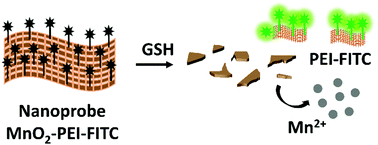Development of manganese dioxide-based nanoprobes for fluorescence detection and imaging of glutathione†
Abstract
Tripeptide glutathione (GSH) is an abundant and ubiquitous metabolite in living organisms and plays critical roles in various cellular processes. In this work, we report the development of a new nanoprobe (MnO2–PEI–FITC) for GSH detection and imaging by exploiting the response mechanism of specific GSH-triggered reduction of manganese dioxide (MnO2) nanosheets. The MnO2–PEI–FITC nanoprobe was developed by coating negatively charged MnO2 nanosheets with a positively charged polyethylenimine (PEI) polymer, followed by coupling with fluorescein isothiocyanate (FITC) through a thiourea linkage. The MnO2–PEI–FITC nanoprobe showed weak fluorescence due to the quenching of FITC emission absorption by MnO2, while the emission of FITC at 518 nm was observed in the presence of GSH. The MnO2–PEI–FITC nanoprobe is featured with a rapid response to GSH (<12 min), high sensitivity (detection limit, 164 nM) and selectivity. The application of this nanoprobe for GSH imaging in fresh yeast cells and onion inner-layer epidermal tissues was then successfully demonstrated. This work thus provides a new nanoprobe for GSH detection and imaging in biological samples.

- This article is part of the themed collection: NJC Emerging Investigators


 Please wait while we load your content...
Please wait while we load your content...